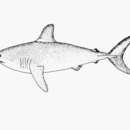Diagnostic Description
provided by Fishbase
First dorsal fin uniformly dark, no light rear tip; ventral surface of body white with dusky blotches (Ref. 247).
- Recorder
- Cristina V. Garilao
Life Cycle
provided by Fishbase
Exhibit ovoviparity (aplacental viviparity), with embryos feeding on other ova produced by the mother (oophagy) after the yolk sac is absorbed (Ref. 50449). Litter size is up to 4 young (Ref. 247). Distinct pairing with embrace (Ref. 205).
Migration
provided by Fishbase
Oceanodromous. Migrating within oceans typically between spawning and different feeding areas, as tunas do. Migrations should be cyclical and predictable and cover more than 100 km.
- Recorder
- Kent E. Carpenter
Morphology
provided by Fishbase
Dorsal spines (total): 0; Dorsal soft rays (total): 0; Analspines: 0; Analsoft rays: 0
- Recorder
- Cristina V. Garilao
Trophic Strategy
provided by Fishbase
A carnivore (Ref. 9137).
Biology
provided by Fishbase
A coastal-littoral and epipelagic shark that prefers boreal to cool temperate waters, from the surface to at least 152 m, and is common in continental offshore waters but range inshore to just off beaches. Occurs singly or in schools or feeding aggregations of several individuals; feeds on fishes (Ref. 247). Seasonally migratory (following food prey) and segregate by age and sex where adults move further north than young (Ref. 58085). Ovoviviparous, embryos feeding on yolk sac and other ova produced by the mother (Ref. 50449). With up to 4 young in a litter (Ref. 247). Fast swimmer (Ref. 9988). Potentially dangerous but has never or seldom been implicated in human attacks (Ref. 247). Causes considerable damage to commercial catches and gear (Ref. 6885). Utilized fresh, dried or salted, and frozen; fins, hides and livers are also used, with fins having particular value; can be broiled and baked (Ref. 9988). Reported to attain at least 27 years of age and reach maximum depth of at least 792 m (in Ref. 119696).
- Recorder
- Kent E. Carpenter
Importance
provided by Fishbase
fisheries: minor commercial; gamefish: yes; price category: unknown; price reliability:
- Recorder
- Kent E. Carpenter

